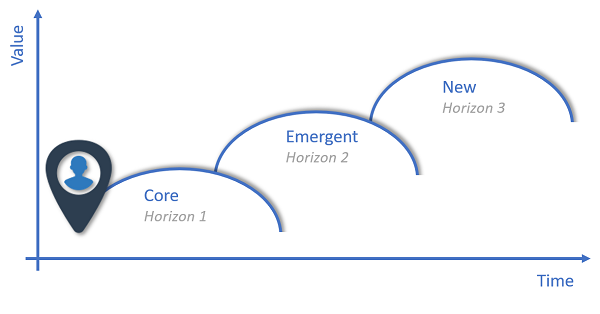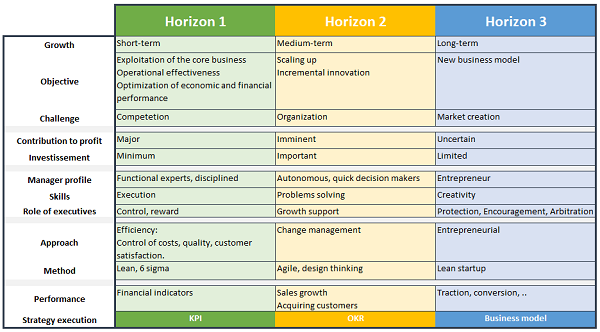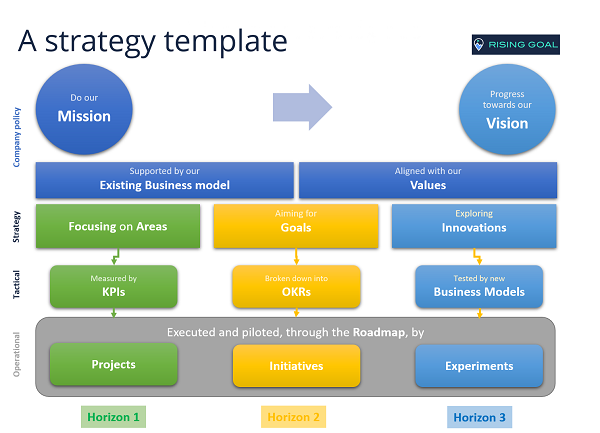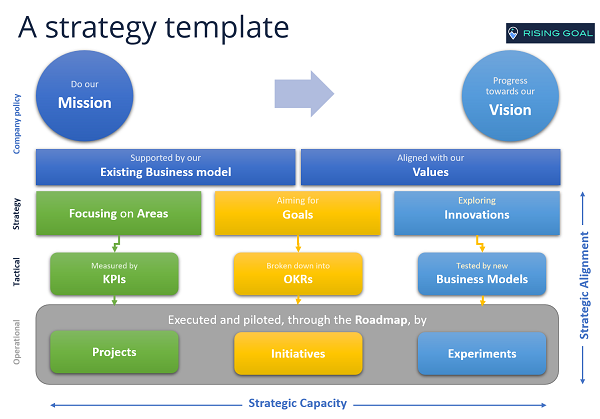The 3 horizons Model
It’s time to strengthen our game in the area of strategy to improve our objectives!
In a previous article, we discussed the dilemma of strategy: reconciling the forces of stability and those of change within the organization!
To solve this dilemma, strategy becomes the mediating force between a dynamic environment and a stable operating system. This is what a method such as the 3 horizons model seeks to solve.
And that’s what we’re going to explore in this article. Then we will reconcile our model of strategy and this model of the 3 horizons. This will make the link with KPIs and OKRs, in a concrete way.
Intro
The 3 horizons model
The objective of this approach is to
develop a shared culture of future consciousness and explore the future as the interaction between the three horizons.
It is a tool for portfolio management of activities. It must be present in any strategic approach as soon as the first activities reach maturity. The goal is to make its fundamentally different activities coexist!
The interest is to have a time frame and adapted approaches for tactical reflections, as we will see.
To learn more about this method, read Sharpe’s book, Three Horizons: The Patterning of Hope.
“Every successful company rides the wave of growth until it peaks and falls. The secret is to create the next wave of growth before the first one collapses.”
The 3 horizons model
Horizon 1, the short-term growth
This is the area of improving the existing. The goal is to manage and develop the core business. This is the most immediate horizon with a strong competitive intensity. It accounts for most of the company’s turnover. And therefore, mobilizes most of its resources. In this horizon, we seek economic and financial performance with a major contribution to the benefit of the company.
To achieve this, the focus is on efficiency: control of costs, quality, customer satisfaction. Operational excellence approaches, such as Lean, are adapted to this horizon. We are trying to make the “cash cows” profitable by limiting investment. Those surpluses make it possible to finance the other star activities and Horizon 2.
The future is rather based on the extrapolation of the past. The measurement criteria are financial with turnover, profit, market share, return on investment. This is typically a KPI approach.
In this context, the hierarchical chain must be in place to arbitrate quickly, while leaving autonomy and initiative. This is why we are trying to reduce the number of hierarchical levels for this horizon. But the temptation to control is great!
As Clayton Christensen describes in his analysis of Disruptive Innovation, innovator’s dilemna, managerial risk is to lock oneself into short-term performance without investing in the future.
Naturally, there is resistance to change. Like a living organism, the social scheme reapplys resources to perpetuate, reproduce and repel the attacks of competitors (internal, horizon 2 & horizon 3).
The 3 horizons model
Horizon 2, the medium-term growth
This is the field of incremental innovation of the existing.
The second horizon is where tensions and transitions are played out between the continuous improvement of Horizon 1 and the transformational possibilities of Horizon 3
It is an ambiguous area. Approaches that manage change and uncertainty well, such as agility, design thinking, are adapted to this context.
The organization listens to its employees and customers in a process of continuous improvement of the existing. And try to make the perfect synthesis between internal and external expectations.
With emerging opportunities and new and fast-growing activities that require significant investments, the challenge is to manage this growth well. Management focuses on organizational implementation. Managers are rather autonomous, able to decide quickly. Executives support this growth effort.
The 3 horizons model
Horizon 3, the long-term growth
This is the field of new activities and disruptive innovation (probably for the organization, perhaps for the market). The challenge is to determine the business model of the activity. The major challenge is that of creating the corresponding market.
It is an area of vision and aspiration, with an entrepreneurial profile. He must be creative, comfortable with uncertainty and controlled risk-taking. We can draw inspiration from methods such as Lean Startup to move forward in this unclear context.
We will thus speak of greenfield projects, without constraints related to the existing a priori (production, infrastructure, …); blue-skies research, without business objectives identified a priori. The contribution to the benefit of the company is still uncertain, as well as its feasibility.
It is a question of implementing the vision, through transformations and structuring changes. We are in more collaborative practices, breaking down silos. The result of the actions requires a permanent adaptation, a learning process and an organic structure. The organization is centered on the outside, in a monitoring and prospecting approach.
The role of the executives is to protect the project, encourage it but also to stop it eventually.
Conclusion
What about our strategy template ?
Naturally, horizon 1 is related to the focus areas & KPIs. Horizon 2 is related to goals & OKRs. And finally, horizon 3 is related to innovation & business model.
Although this is a simplification, it helps to better understand that OKRs are not used to manage all the work, all the activities within a company and teams. Which would be a mistake. OKRs manage only part of it. The rest must be followed differently.
And here is the strategy template as a whole:
And this brings us to the following question we ask during our coaching missions: how much do you allocate to the core business (H1, KPI), change (H2, OKR) and innovation (H3, business model)?
This is one of the points of strategic capacity, the company must be organized to make the best possible use of its resources and skills.
And you, what model do you use to make this distinction?
— updated 26/05/2022
I was deligthed to discover that Daniel Montgomery, during the OKRX Summit 2022, use the same model, with a small difference, called the strategic horizons :
From his point of view, Horizon 1 is clearly linked to KPIs and Horizon 2 to OKRs. What is different in our model, is that in Horizon 2, the OKRs are committed OKRs (or roofshot OKRs) , whereas in Horizon 3 is linked to Moonshot OKR. That a good point.
Related Posts
The strategy dilemma
How will you reconcile the tension between focus areas (the forces of stability) and goals (the forces of change) ?
A strategy template
A strategy template, to strengthen our game in the area of strategy to improve our objectives and key results !









Recent Comments